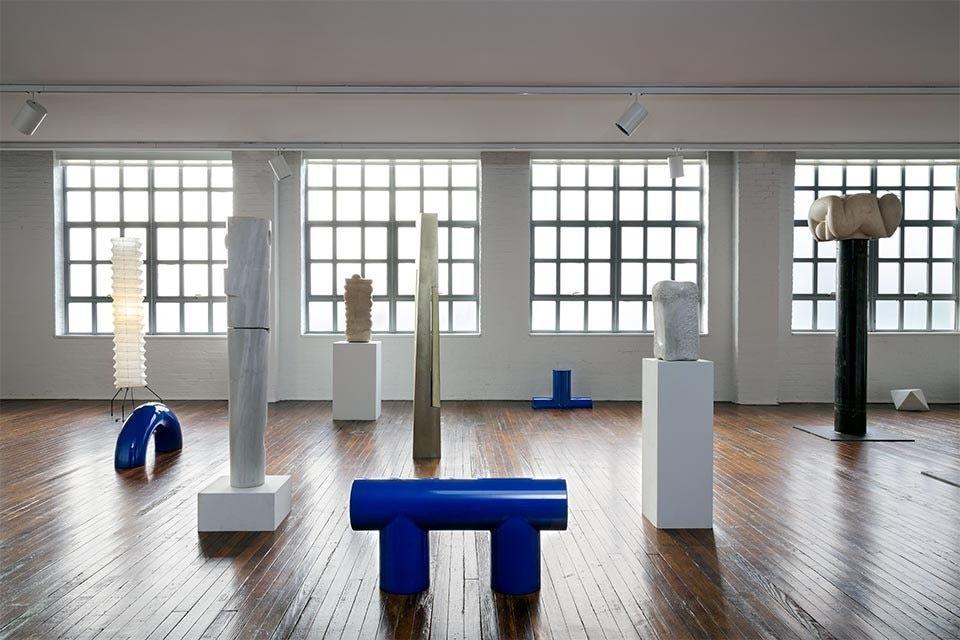The “Hard, Soft, and All Lit Up with Nowhere to Go” exhibition opened its doors to the New York public on September 15th at the Noguchi Museum. Curated by Mr. Dakin Hart, the initiative features Eleni Petaloti and Leonidas Trampoukis, two Hellenic designers based in New York and Athens also known as Objects of Common Interest. Preceded by a digital collaboration entitled “Noguchi in Greece, Greece Within Noguchi” created thanks to the documentation present in the museum archive, “the curatorial initiative aims to make the point of view of Isamu Noguchi understand through the work of the two designers, a figure not interested in definitions and categories who intended to shape human experience and understanding of the world through his sculpture”, says Mr. Dakin Hart.

The exhibition itinerary extends into the internal and external area of the museum allowing the visitor a changing interpretation of the exhibited works; Eleni Petaloti says that the aim is to establish a dialogue within the museum characterized by confrontation, integration and spatial relationships that arise within the architectural space. Formally, what unites the protagonists of the exhibition is an intuitive approach to the project characterized by a dialogue between the world of art and design which in this specific case represents the link between the work of Isamu Noguchi and Objects of Common Interest.

The opposition to rationality in design evokes a sense of spirituality which in the exhibitions of the Noguchi Museum becomes the common thread that connects each exhibition, such as the one that preceded “Hard, Soft, and All Lit Up with Nowhere to Go” by Christian Boltanski before his passing last July.

The installation involved the arrangement in the museum garden of 180 bells that tinkled in the wind generating a sort of music of lost souls, says Mr. Dakin Hart, who subsequently illustrates the reason why the Noguchi Museum decided to host Eleni Petaloti and Leonidas Trampoukis: “We were hoping that “Objects of Common Interest: Hard, Soft and All Lit Up with Nowhere to Go” would provide a kind of nonspecific existential exhale. On the other side of the goal crisis. As usual, reality has had a different idea. But I hope it still manages to present an alternative set of uncertainties–ones that aren’t quite so crushing, and in terms of their brightness and lightness, their pure, agendaless hopefulness, provide a measure of cathartic release.”

Mr. Dakin through this supply seeks an example of how an interdisciplinary project can go beyond certain predetermined labels of the past, supporting Noguchi's idea that labeling an object with the word design would imply the quixotic fashion of the time. Years after his death and with a world where codes have ceased to exist, the thought of the American sculptor assumes a prophetic and inspiring role to which even the Objects of Common Interest would seem to refer in their daily work: “design as a label it connotes a usable and commercial element and prevents its product from crossing those pre-established boundaries, becoming a thing in itself”; declare the two Hellenic designers.

The collaboration between the Noguchi Museum and Objects of Common Interest will be followed by an artist's book in which the work already presented in “Noguchi in Greece, Greece Within Noguchi” will be further explored, with the aim of further helping readers to understand the relationships of Isamu Noguchi with Greece. According to Mr. Dakin Hart, the most significant aspect of this publication will be the fact that, being written by two artists, it will be less didactic, expository and limiting than the way it is usually done by curators.

Metamorphosis: when ceramics lives with technology
Iris Ceramica Group presents "Metamorphosis" at Fuorisalone 2025, an experience that merges art and technology, featuring interactive installations and innovative surfaces.




























